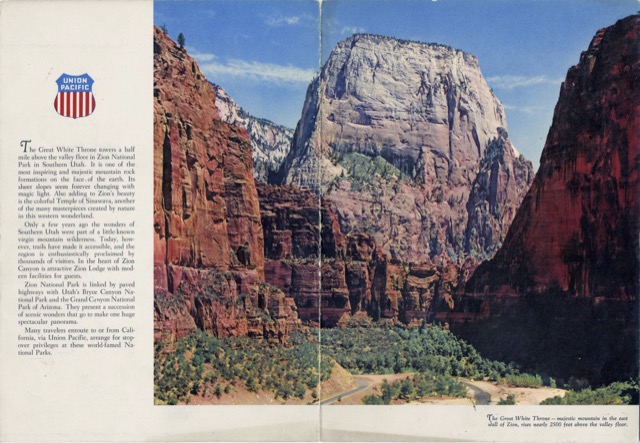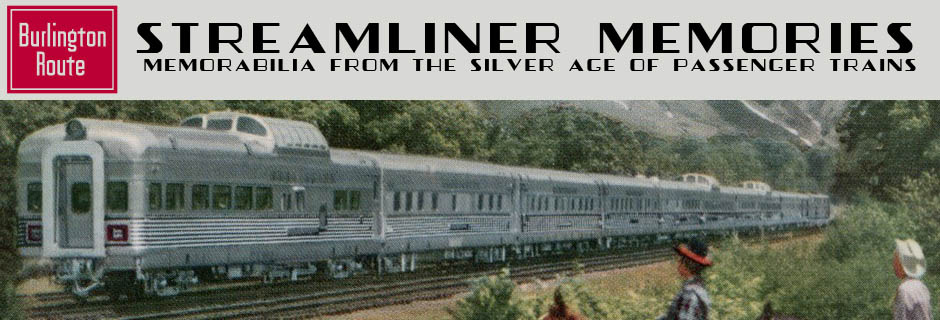We’ve seen this menu cover before, but what’s unusual about this menu is on the inside. First, it is dated 11/46, making it the oldest UP postwar color photo menu that I’ve seen and the only one from 1946 in my collection.

Click image to download a -MB PDF of this menu.
Second, the top of the inside pages, where many UP menus list the name of the train, say “Transcon.” Next to the date in the lower right corner it also says, “(3&4),” indicating the menu was used on trains 3 and 4. In 1947, that would have referred to the Utahn, a Los Angeles-Cheyenne train that was trains 3 and 4 in UP’s 1947 timetable. But in 1946, Union Pacific had inaugurated a train called the Transcon, with numbers 3 & 4. This train isn’t well known because it operated for just seven months.
The story began in 1937, when the Pennsylvania approached Union Pacific and Santa Fe about running through trains all the way from New York to the West Coast with a total run time of 56-3/4 hours. Given that the Broadway and 20th Century took 16 hours to get from New York to Chicago and UP and Santa Fe had trains that took 39-3/4 hours to get from Chicago to Los Angeles, 56-3/4 hours made sense — if you didn’t count the time it would take to get cars from one station to another in Chicago. The Pennsylvania operated at the same station as the Burlington and Milwaukee Road, but neither of those railroads had 39-3/4-hour trains to the West Coast. New York Central operated at the same station as Rock Island, so the 20th Century-Golden State route was possible, but the Golden State route never got down to 39-3/4 hours either.
An even bigger problem was timing: railroads from both the east and the west scheduled their fastest trains to arrive in Chicago in the morning and depart in the evening, thus minimizing the business hours occupied on a train. To meet a 56-3/4-hour schedule, someone would have to schedule a fast train to arrive in Chicago in the evening or leave in the morning.
In 1937, however, the biggest problem was that neither UP nor Santa Fe had enough equipment to support such a train. At the time, the City of Los Angeles and the Super Chief only went four times a month. To the extent they expressed an interest, UP and Santa Fe said they preferred through cars on existing trains rather than through trains.
World War II intervened, but less than three months after the war ended, the passenger traffic managers for the Pennsylvania (C.H. Matthews) and New York Central (F.H. Baird) sent a confidential memo to their counterparts at the Burlington (A. Cotsworth, Jr.), Chicago & North Western (E.L. Pardee), Great Northern (A.J. Dickinson), Milwaukee Road (F.N. Hicks), Rock Island (A.D. Martin), Santa Fe (T.B. Gallaher), Southern Pacific (Claude Peterson), and Union Pacific (C.J. Collins) railroads. For some reason, Northern Pacific was not on the list.
The memo offered a “suggested program for through transcontinental passenger train service between New York and Los Angeles-San Francisco-Seattle.” Specifically, it proposed “four trips per week” between New York and Los Angeles, two trips between New York and San Francisco, and “a minimum of two trains per week” between New York and Seattle. Each train would consist of at least a baggage car, three coaches, coffee shop-lounge, diner, five sleepers, and an observation-lounge-sleeping car.
Still pleading equipment shortages, the Santa Fe agreed to begin running through cars to New York using a combination of the 20th Century Limited and the Chief. Because the Chief wasn’t as fast as the Super Chief, and there was a four- to six-hour layover in Chicago, the entire trip took 65-1/2 hours. But it left New York at 6 pm and arrived in Los Angeles at 8:30 am after three nights of travel, thus costing the traveler no more than two business days. Pennsylvania and Baltimore & Ohio hastily joined in so that a car from the Broadway Limited and a car from Washington on the Capital Limited were included in the daily consist of the Chief.
Union Pacific quickly issued a press release saying that, starting June 2, it would operate a train called the Transcontinental from Chicago to Los Angeles on a 49-1/2-hour schedule to carry NYC and PRR cars from New York and Washington. Union Pacific’s 1946 timetable shortened the train’s name to Transcon.
Following the NYC/PRR memo’s recommendation, the timetable noted that the train included three coaches, a diner, and an “observation sleeping car” that included ten sections, leaving room for a small observation lounge but no beverage service. The train apparently did not include a coffee shop-lounge car. Leaving Chicago four hours ahead and Los Angeles 90 minutes ahead of the Los Angeles Limited, the Transcon doing dual duty of providing coach service for people who liked that schedule (the Challenger left Chicago six hours and Los Angeles nine hours after the LA Limited) and carrying the transcontinental sleepers without overcrowding Union Pacific’s premiere daily train.
Considering the time required to transfer passenger cars between the LaSalle or Union stations and the North Western station, the Transcon was scheduled to depart Chicago in the mid-morning, 2-1/2 hours after the connecting trains from the east arrived. Nor was the Transcon put on a 39-3/4-hour schedule: using heavyweight equipment, the train required 49-1/3 hours to get to Los Angeles. Connecting with New York Central’s Commodore Vanderbilt from New York and Pennsylvania’s Admiral from New York and Liberty Limited from Washington, the total time from New York to Los Angeles was almost 70 hours.
The Transcon didn’t last for long, probably because the eastern railroads couldn’t generate enough business to justify dedicating an entire train to the route. By January 1, 1947, the Transcon had disappeared from Union Pacific’s timetable and the Los Angeles Limited did the honors of carrying the New York and Washington sleepers. With about a three-hour layover in Chicago, the total New York-Los Angeles travel time was about 71 hours. By effectively taking three business days each way, the service was uncompetitive with the Santa Fe’s Chief. After the Los Angeles Limited was terminated, the through cars went via the City of Los Angeles, but rather than run them on eastern trains with close connections, the railroads settled for Chicago layovers of four to ten hours.
Eventually, other through cars went on the San Francisco Overland, Exposition Flyer (later the California Zephyr), and Golden State Limited. There were also through cars from New York and Washington to Texas on various railroads. On some of these routes, through cars continued to operate through about 1958.
The Great Northern and Milwaukee didn’t bite, however, as no through cars were ever regularly scheduled between New York and Seattle or, for that matter, Portland. Perhaps if the New York Central and Pennsylvania had remembered to include Northern Pacific on its list of recipients for its 1945 memo, the competitive pressure would have been enough for the northwest railroads to try it out.
In any case, the Transcon was the only train specifically created to carry through New York-West Coast cars. If passenger ridership hadn’t rapidly dwindled after the war, it is possible that more railroads would have inaugurated through trains with schedules optimized for coast-to-coast travel, as originally proposed by PRR. But by the time equipment became available, airplanes were rapidly taking passengers away from long-distance trains.
